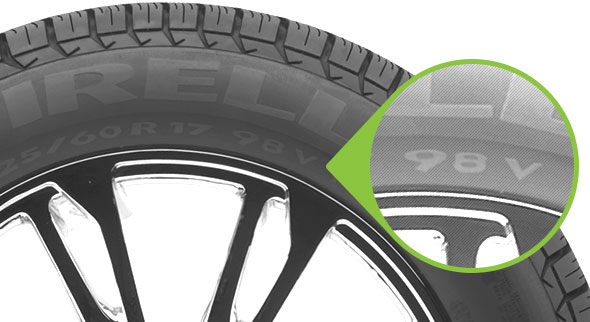Tyre Speed Ratings
Speed ratings were established to match the speed capability of tires with the top speed capability of the vehicles to which they are applied. Speed ratings are established in kilometers per hour and subsequently converted to miles per hour (which explains why speed ratings appear established at “unusual” mile per hour increments). Despite the tire manufacturer’s ability to manufacturer tires capable of high speeds, none of them recommend the use of their products in excess of legal speed limits. The maximum operating speed of a vehicle must be limited to the lowest speed rated tire on the vehicle.
Speed ratings are based on laboratory tests where the tire is pressed against a large diameter metal drum to reflect its appropriate load, and run at ever increasing speeds (in 6.2 mph steps in 10 minute increments) until the tire’s required speed has been met.
 Over the years, tire speed rating symbols have been marked on tires in any of three ways shown in the following examples:
Over the years, tire speed rating symbols have been marked on tires in any of three ways shown in the following examples:
225/50SR16 225/50SR16 89S or 225/50R16 89S
Given below is the Speed Rating Table to help you find the Speed Rating for the corresponding Speed Rating letter on your tyre
[custom_table]
| Speed Rating | Kilometers/Hr | Miles/hr |
|---|---|---|
| L | 120 | 75 |
| M | 130 | 81 |
| N | 140 | 87 |
| Q | 160 | 99 |
| R | 170 | 106 |
| S | 180 | 112 |
| T | 190 | 118 |
| U | 200 | 124 |
| H | 210 | 130 |
| V | 240 | 149 |
| Z | 240+ | 149+ |
| W | 270 | 168 |
| Y | 300 | 186 |
[/custom_table]
It is important to note that speed ratings only apply to tires that have not been damaged, altered, under-inflated or overloaded. Additionally, most tire manufacturers maintain that a tire that has been cut or punctured no longer retains the tire manufacturer’s original speed rating, even after being repaired because the tire manufacturer can’t control the quality of the repair.


0 Comments